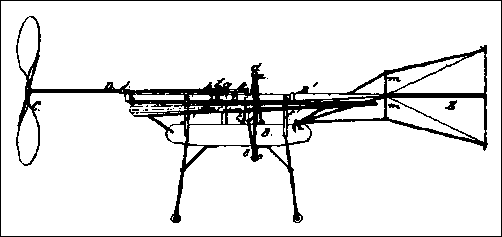In West Dennis, Massachusetts, meanwhile, another inventor was pressing the New Yorker for the honor of obtaining this country's first patented helicopter design. He was Luther C. Crowell, and his aerial device was recognized by the Patent Office on June 3, 1862.
Crowell's machine called for some unique mechanical features. For example, the two propellers with which it was equipped were fastened to shafts that could be swung from a vertical position to a horizontal. Thus, when it was flying as a helicopter, that is, in a vertical direction, the propellers would be above the aircraft's body. For forward flight they were supposed to be lowered to a horizontal position. Incidentally, he also realized that these had to rotate in opposite directions to counteract torque. In addition to the movable propellers, the designer also equipped the craft with adjustable wings. For up and down flight the wings could be lowered to a vertical position. After reaching the desired altitude, the pilot was then supposed to bring the wings up horizontally for flying in a forward direction. Another curious thing about the wings was the fact that they were hollow and were to be filled with hydrogen or some other lifting gas. Wood and a covering of either oiled cloth or silk was suggested for their construction. Once aloft, the helicopter was supposed to be steered in any desired direction by a pyramid-shape rudder fixed to the stern of the fuselage. This was accomplished by means of cords and pulleys extending into the pilot's compartment.
Like most of his contemporary aircraft inventors, Crowell was precise with his directions for building the structure of his flying machine. About ways of powering his helicopter, however, he was quite vague. He merely called for a steam engine. The inventor probably felt that the problems of installing a power plant as bulky as this was so great, they had better be left to someone else.
Crowell worked out his helicopter design just as the American Civil War was getting under way, which undoubtedly influenced his thoughts concerning possible uses for his flying machine. He suggested that it could be used for bombing purposes. "When it is desired to employ this aerial machine as an engine of war, it could be elevated, loaded with shell, and when arrived over the desired spot the shell could be discharged," he commented.
Frank Ross Jr. "Flying Windmills", 1953





